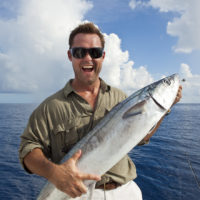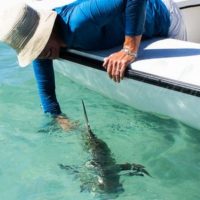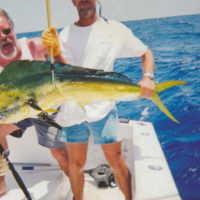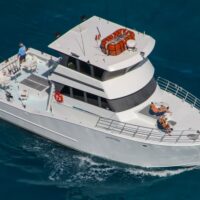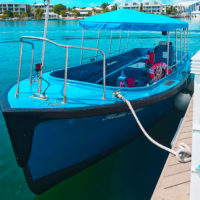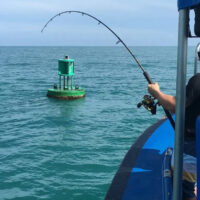Fishing for Kingfish in Key West
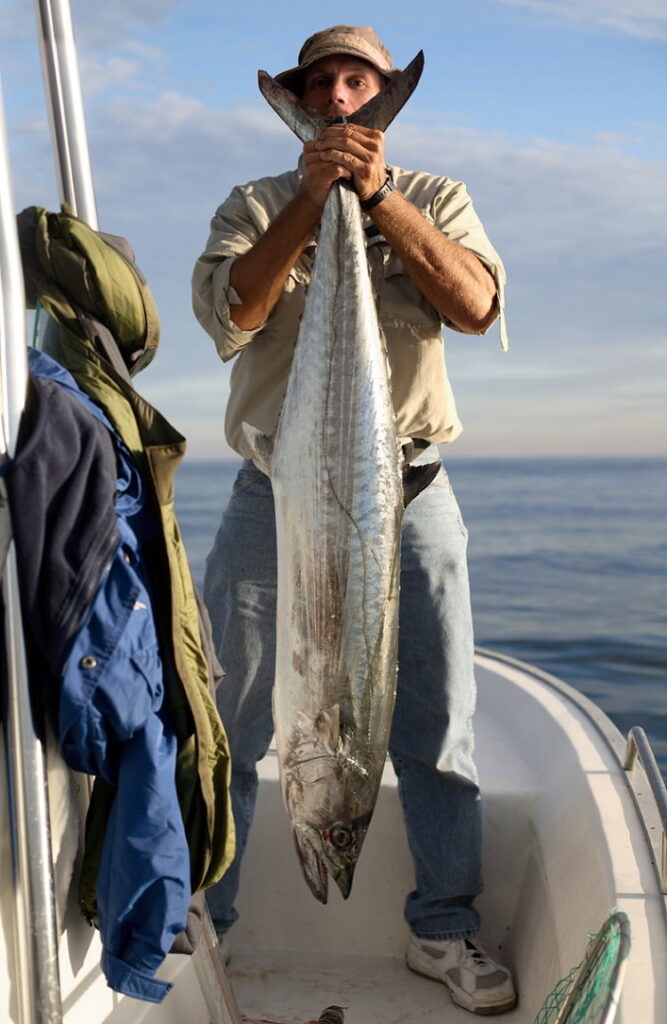
Blazing fast, unpredictable in the fight, and voracious on the hunt, the Kingfish is a prize in the world of Key West sportfishing and comes in just behind the Wahoo as the second largest of the Mackerel family Scombridae. From the Carolinas to the Keys, Kingfish fans know that Key West is home to some of the largest Kings on the western Atlantic coast. (Florida Record: 90lbs)
Kingfish (Scomberomorus cavalla)
The Kingfish, or King Mackerel, is one of about 21 species of the family Scombridae that are commonly known as Mackerel. Like Wahoo and Cero Mackerel, two other popular Key West gamefish, Kingfish are classified as Spanish Mackerels in the subfamily Scombrinae, tribe Scomberomorini. Like most of the Mackerels, Kingfish are long, sleek, and fast-looking, with a stiff, deeply-forked, Tuna-like tail fin made for powerful bursts of speed. Also like Tuna, Kingfish have symmetrical second dorsal and anal fins along with scutes along the top and bottom of the tail to enhance stability at speed.
Kingfish are covered with tiny, loosely attached scales. The back of the fish is marbled olive-black with iridescent blue and green colors, fading to silver with a rosy iridescence on the sides and to white on the belly. Some fish have distinct bars or spots, and young individuals under 10lbs show 5 or 6 irregular rows of yellowish-brown spots on their flanks. Kings can be distinguished from the closely related Cero and Spanish Mackerels by the lack of a black spot on the rear portion of the first dorsal fin. Cero Mackerel also have a yellow line and short yellow bars along the body, while Spanish Mackerel have yellow spots.
The head and snout of the Kingfish are pointed, and the long jaws extend back below the large eye. The mouth is filled with large, closely spaced, flattened cutting-edged teeth very similar to those of Bluefish. Kingfish commonly reach 19 to 35 inches in length, with a maximum reported size of 72 inches in length and 99lbs in weight. Fish caught around Key West are generally in the 10- to 30-pound range with occasional 60-pounders coming into the docks.
Kingfish Habitat and Behavior
The Kingfish is a subtropical species found along the western coast of the Atlantic Ocean and in the Gulf of Mexico. Most common in the coastal zone from North Carolina to Brazil, Kingfish occur as far south as Rio de Janeiro, and occasionally north to the Gulf of Maine. Kingfish prefer water temperatures in the range of 66 to 85 °F, which may limit their distribution. They usually swim along outer reefs and in coastal waters with depths between 75 to 115 feet, but they are sometimes found out to depths of 600 feet at the edge of the Gulf Stream. However, larger fish over 20lbs are frequently encountered inshore around piers and in the mouths of inlets and harbors.
As one of the most popular gamefish species from the Carolinas down to southern Florida waters and along the Gulf Coast, the Kingfish has been fairly extensively studied. Tagging programs have revealed two migratory groups of Kingfish existing in the western Atlantic. A Gulf of Mexico group lives along the Texas coast in summer and migrates to the middle-east coast of Florida from November through March. This group spawns off the northern Gulf Coast throughout the summer. An Atlantic group is found off North Carolina in the spring and fall. This group migrates to southeast Florida to spawn from May through August, and slowly returns north throughout the summer. The Atlantic group appears to winter in deep water off the Carolinas, as tagged individuals are never found off Florida in winter. The Atlantic Ocean and Gulf of Mexico groups mix as they pass through south Florida waters. Peak spawning periods occur between late May and early July and between late July and early August.
Female sexual maturity may first appear in Kingfish as small as 17 to 19 inches in length, and usually occurs by the time a length of 35 inches is reached. Fertilization is external, and eggs are released and fertilized at intervals throughout the spawning period. Depending on its size, a female Kingfish may release from 50,000 to several million eggs during a spawning season. A fertilized egg hatches in about 24 hours, releasing a tiny .098 inch-long larva with a large yolk sac. Little is known about the first year of life for Kingfish, but larvae seem to be pelagic and are encountered in surface waters of 79.34°F to 87.8°F.
A study conducted in the Atlantic and Gulf of Mexico documented female fish as old as 26 years, males up to 24 years, and fish from 14 to 17 years old were also recorded. Fish over 20 years old were rare. By age seven, female fish average 21lbs and males 11lbs. Any fish over 15lbs is almost always a female.
Kingfish are voracious, opportunistic carnivores that take different prey depending on their size, on the area, and on the season. They feed primarily on other fishes, favoring squid, menhaden and other sardine-like fish, jacks, cutlassfish, weakfish, grunts, striped anchovies, cigar minnows, threadfin, northern mackerel, and blue runners. In south Florida, ballyhoo are the food of choice for the King Mackerel, while on the east coast of Florida, they prefer anchovies, flying fish, drums, jacks, mullet, and Spanish sardines. Kings will also occasionally eat crustaceans and mollusks. Adult Kingfish mainly eat baitfish that are 4- to 6-inches long.
Fishing for Kingfish
Kingfish are one of the most sought-after gamefish throughout their range from North Carolina to Texas. The Kingfish is similar to the Wahoo in speed, and is known for reel-stripping runs that give Kings over 25lbs the nickname of Smokers due to the fact that a drag may heat up working to slow a big King down. Other King Mackerel fishermen say the name refers to the fact that Kingfish meat is great for the smokehouse and excellent when used in fish dip.
When Kingfish are spawning in the Atlantic and the Gulf, they can be found in huge schools. Guides look for large flocks of diving birds to help locate these schools. Kingfish can also be found around nearly any structure that holds baitfish. Trolling with live or dead baitfish, spoons, or skirted squid imitators is the most common way to catch Kingfish. Dropping jigs and live baits works when fish are over a reef or around structure. Kingfish are sometimes caught as by-catch when dropping live bait for Snapper or other reef fish.
Typical Kingfish trolling tackle includes a 7-foot 30lb-class rod mounted with a conventional or spinning reel capable of holding 300 yards of 30 lb. test line. A live-bait rig is two hooks tied to a strong metal leader, with the first hook placed through the live bait’s nose and/or mouth and the second hook put through the top of the back or allowed to swing free. This is done because King Mackerel commonly bite the tail section of a baitfish. When trolling bait rigged this way, it is important to make sure the baitfish swims properly. For slow-trolling live baits or casting lures into a feeding school of Kings, light spinning tackle may be used with 12-20lb line running to a 30lb leader connected to a #5 wire leader.

